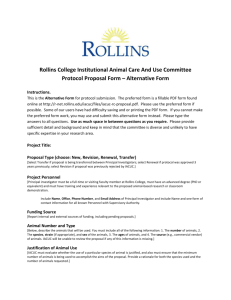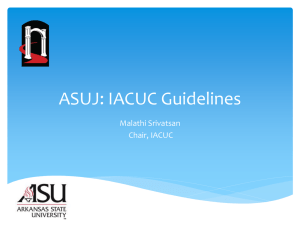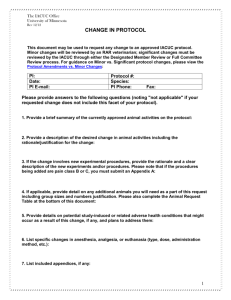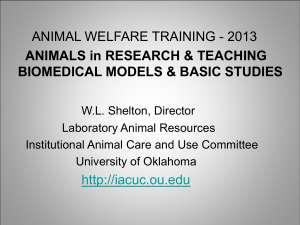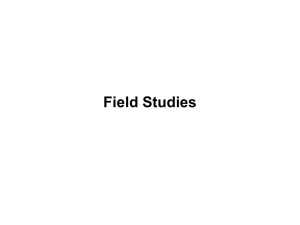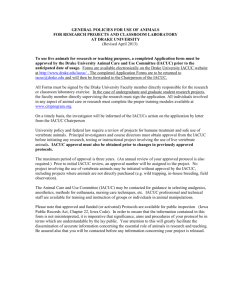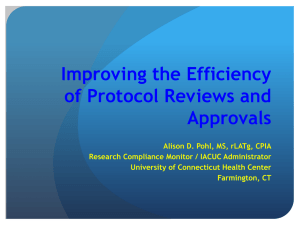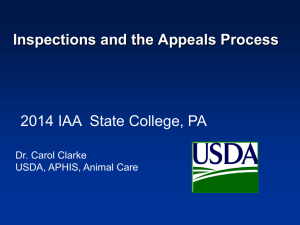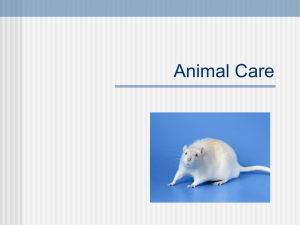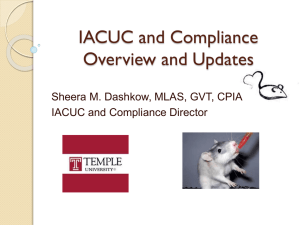Institutional Animal Care and Use Committee (IACUC)
advertisement
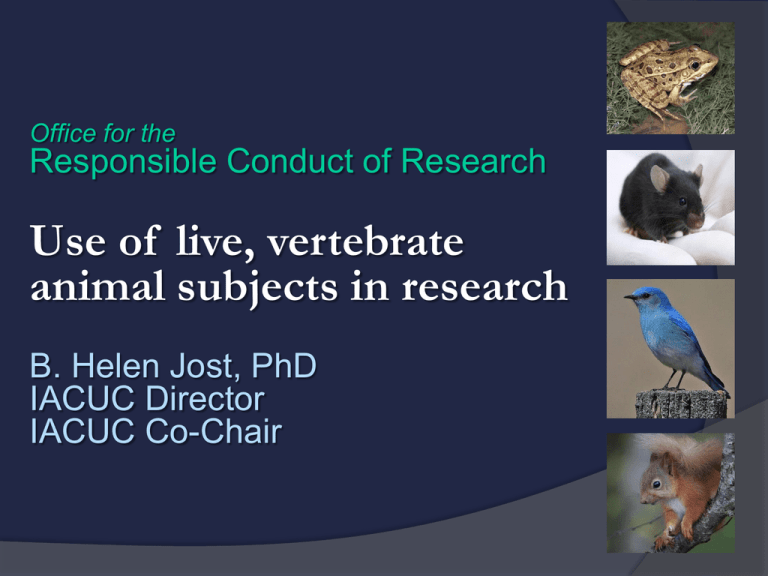
Office for the Responsible Conduct of Research Use of live, vertebrate animal subjects in research B. Helen Jost, PhD IACUC Director IACUC Co-Chair Historical use of research animals Research animals have been used as human surrogates for well over a century Without regulation Often without concern for animal welfare During that time, there were a number of animal cruelty laws in several states across the country However, there were no laws that specifically addressed the procurement and use of animals in research Genesis of animal research regulation Several affiliated research groups formulated and used standards of care for rodents Standardized conditions were important to experimental reproducibility Animal welfare was also considered (3 R’s) Dognapping of “strays” to sell to research labs was a reality In 1965, a story in Time about Pepper the Dalmatian sparked a strong desire across the country to halt this practice The Animal Welfare Act The Animal Welfare Act (AWA) was enacted in 1966 Only included dogs and cats The AWA covers animals used in commerce, exhibition, teaching, testing, and research The AWA excludes: Cold-blooded animals (reptiles, fish, frogs) Animals used for agriculture (cattle, pigs, sheep, goats, horses, llamas) Mice, rats and birds purposely bred for use in research ■ 90% animal research uses lab mice and rats AWA oversight Unannounced inspections by a USDA Veterinary Medical Officer (VMO) The VMO is charged with identifying non-compliance with the AWA and its regulations Visits facilities, inspects animals, reviews records Non-compliant items (NCIs) are published on-line and may incur fines Identification and correction prior to inspection is not cited as an NCI Public Health Service Assurance Institutions receiving PHS funds for animal research must assure that research will be conducted as described in the PHS Policy on the Humane Care and Use of Laboratory Animals Must follow all applicable laws Must follow the Guide to the Care and Use of Laboratory Animals The Assurance is renewed every 5 years, with reports submitted annually Without this Assurance there is no NIH/NCI funding for research involving animals OLAW oversight The Office of Lab Animal Welfare monitors compliance with the PHS Policy OLAW uses a mechanism of self-policing and self-reporting The institution identifies non-compliance and reports to OLAW with corrective actions There are no unannounced inspections However, audits can occur, usually for cause Serious and uncorrected violations can result in the loss of PHS funding To individuals To the institution as a whole AAALAC accreditation Association for the Assessment and Accreditation of Laboratory Animal Care AAALAC is a voluntary organization that makes recommendations based on results of site visits Standards are continually updated to reflect current knowledge in laboratory animal science OLAW accepts AAALAC accreditation in lieu of additional OLAW oversight Regulatory authority at UA The University of Arizona is: Registered with the USDA as a research institution PHS assured AAALAC accredited The Institutional Official (IO) has ultimate responsibility for the animal care and use program Vice President for Research The Institutional Animal Care and Use Committee (IACUC) administers the animal care and use program The IACUC IACUC membership must include: Scientists Veterinarians Non-scientists Non-affiliated “community” members Due to the diversity of the Committee, the rationale for the use of animals must be written in easy to understand language The “lay” description Unlike humans, animals can’t consent The IACUC acts as their voice IACUC responsibilities Oversees the Animal Care and Use Program Make recommendations to the IO for improvements Inspects animal housing and research labs Semi-annual inspections Ensures protocol participants have training To understand the laws and ethics of animal research To conduct specific animal activities To understand occupational health issues Reviews and approves animal research and teaching Protocols and amendments IACUC review of animal studies IACUC review and approval is required for all activities involving warm and cold blooded vertebrate animals, including: Research Teaching Agriculture or field studies Use of UA-funded animals at other institutions Approval must be obtained before the work begins Description of animal activities A brief description of the aim/purpose A narrative description of all animal activities, in the order they will occur Identification of the scientific endpoints The point at which the experimental aims are met Identification of humane endpoints The point at which animals must be removed from the study, even if the experimental aims are not met Identification of pain and distress Clinical signs How will pain/distress be alleviated? Why can’t pain/distress be alleviated? Modifications to approved activities Any changes in your research with animals must be approved before the work starts Additional animals or species Addition of new strains or breeding New or modified procedures or time points Additional of surgery Additional drugs/compounds Changes in dosages/administration route Changes in euthanasia methods The ethical balance Scientific value Ethical cost To humans Pain To animals Distress To science Morbidity To society Mortality The 3 R’s (Russell and Birch, 1959) 3 R’s are one tool that the IACUC uses to balance the scales The Can we replace the use of animals with non- animal models or lower species? Can we reduce the number of animals used and still achieve statistically significant data? Can we refine the procedures to minimize or eliminate pain and distress? Do animals need to be used? Does the benefit outweigh the harm to the animal? The data can be translated into future human or animal clinical studies ■ Development of drugs or therapies When there are clear benefits to society and the advancement of knowledge ■ Species ecology and conservation Can a non-animal model be used? In vitro assays, tissue culture Computer models, simulations Manikins, especially for training Does the species need to be used? Hierarchy of species Non-human primates Farm animals (cattle, pigs, sheep) Rabbits, ferrets USDA regulated Companion animals (dogs, cats) Guinea pigs, hamsters, gerbils Lab rats Lab mice Fish, frogs Invertebrates Ag and field studies do not follow this paradigm Not animal models Are the fewest animals used? The number of animals requested must be justified The number of animals per experimental group should be consistent with generation of scientifically sound data Justification can include use of: A statistical method to ensure a p value Previously documented experience (PI or literature) The most important R – refine? Review current scientific literature to identify modified techniques that reduce pain or distress Use appropriate sedation, analgesia and/or anesthesia for painful or distressful procedures Limit the number of procedures experienced by any individual animal Ensure adequate post-procedural care Know the signs of pain and distress Identify appropriate scientific and humane endpoints Remove animals from the study based on humane endpoints to minimize pain and suffering The ethics of animal research Animal research is affected by the same ethical issues as other kinds of research Data fabrication or falsification; researcher bias; conflict of interest; intellectual property issues; misuse of funds However, there is also protocol non-compliance, that is performing animal activities that have not been reviewed and approved by the IACUC Non-compliance may be reportable to the USDA or OLAW It is critical that everyone know what is approved Submit amendments to modify animal activities before starting the work The ethics of animal research As scientists, we should be aware of the impact that animal research has on our accumulated knowledge Much of what we know about the biological sciences had its start with animal research Most human studies being conducted today rely directly or indirectly on data from animal studies However, animal research should only be undertaken After careful consideration of the scientific value obtained as compared to the ethical cost of using animals With the utmost concern for animal welfare IACUC Contacts Sean Limesand, PhD, IACUC Chair Phone: 626-8903 Email: limesand@email.arizona.edu David Besselsen, DVM, PhD, Attending Veterinarian Phone: 626-1066 or 621-1564 Email: besselsd@email.arizona.edu Helen Jost, PhD, IACUC Director and IACUC co-Chair Phone: 626-5304 Email: jost@email.arizona.edu Or email: ORCR-iacuc@email.arizona.edu Resources USDA Animal Welfare Act http://www.aphis.usda.gov/wps/portal/aphis/ourfocus/an imalwelfare?1dmy&urile=wcm%3apath%3a%2Faphis_ content_library%2Fsa_our_focus%2Fsa_animal_welfar e%2Fsa_awa%2Fct_awa_program_information PHS Policy http://grants.nih.gov/grants/olaw/references/phspol.htm The Guide http://grants.nih.gov/grants/olaw/Guide-for-the-Care- and-Use-of-Laboratory-Animals.pdf IACUC home page http://orcr.arizona.edu/iacuc
